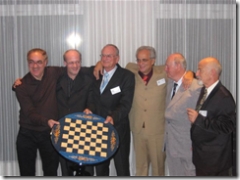With Black Kramnik played like a wall so far in the match. The wall stood still, and when Topalov threw something at it, it came back to him. In game nine however, after
1.d4 d5 2.c4 c6 3.Nf3 Nf6 4.e3
Kramnik deviated from game seven (4..e6) and played
4..Bf5
allowing Topalov to play the line
5.Nc3 e6 6.Nh4
where Topalov had prepared a new line and won in a very convincing way.
The wall had moved and collapsed. I don't understand why Kramnik did not continue to play like a wall and repeat the line from game seven. I think this was a bad idea, and he should have repeated the line from game seven. I will come back to this for the game eleven preview. If you have any idea why Kramnik played like this, please let me know - you can send me feedback at bennedik@gmx.net.
Now Kramnik faces a difficult situation. He is behind for the first time in the match, and there are only three games to go. It will be crucial to create winning chances with White in game ten.
But first lets have a look at game eight, and what this means for game ten:
In game eight Topalov abandoned the Catalan and switched to the Slav. While the Catalan had not been a desaster, Kramnik was able to steer the games away from complications and towards the technical positions he plays so well. Therefore I think Topalov made a wise decision by switching to the Slav.
1.d4 d5 2.c4 c6 3.Nf3 Nf6 4.Nc3 e6
Kramnik with Black played 4..dxc4 in this position in games two and six, here.
5.e3 Nbd7 6.Bd3 dxc4 7.Bxc4 b5 8.Be2
Topalov played 8.Bd3 in this position in game four.
8..Bb7 9.O-O b4 10.Na4 c5
Topalov has prepared a rare line. Now 11.Nxc5 Nxc5 12.dxc5 Bxc5 13.Qa4+ Ke7 is ok for Black.
11.dxc5 Nxc5
Now 12.Nxc5 Bxc5 would transpose to the last note.
12.Bb5+ Ncd7 13.Ne5 Qc7 14.Qd4 Rd8 15.Bd2
Hannes Langrock at chessgate.de proposes the greedy 15.Qxa7 Bd6 16.f4 O-O 17.Nxd7 Nxd7 18.Bd2 and asks if Black has enough compensation. I think yes, for example 18..Nf6 (Black has to make room for the queen) 19.Rfc1 (or Rac1) Qe7 and the White pieces on the queenside have gone astray. Black will make moves like Rd8-a8-a5, Rf8-d8 or a8, Nf6-d5 or e4.
15..Qa5
This is Topalov's new move.
16.Bc6 Be7 17.Rfc1
Here 17.b3 or 17.Rac1 are alternatives.
After 17.b3 O-O 18.Bxd7 Nxd7 19.Nxd7 Black can choose between 19..e5!? 20.Qxe5 Qxe5 21.Nxe5 Rxd2 with a very nice bishop pair for the pawn (Hannes Langrock) or 19..Bc6, which is also fine.
17..Bxc6 18.Nxc6 Qxa4
Now Kramnik played 19.Nxd8 and lost the endgame after 19..Bxd8 20.Qxb4 Qxb4 21.Bxb4 Nd5 22.Bd6 f5.
There are some interesting alternatives on move 19:
Stefan Löffler looks at 19.Bxb4 e5 20.Qh4 Bxb4 21.Nxd8 O-O 22.Nxf7, but after 22..Rxf7 23.a3 e4 24.axb4 Qxb4 25.Rxa7 Qxb2 I think Black's two knights may be better than White's rook.
But very interesting is the sharp
19.Nxe7 Kxe7 20.Bxb4+ Ke8 21.b3 Qb5 22.Rd1
Now Vladimir Below analyzes
a) 22..Qe5 23.Qxa7 Nd5 24.Ba5 Rc8 25.e4 Qxe4 26.Rd4 Qf5 27.Re1 "and it is difficult for Black to untie".
b) 22..Qb6 Peter Svidler thinks "sooner or later the extra piece will tell", but Belov gives 23.Qc3 "and it is not easy to find the way for Black to unpin, while White’s attack develops naturally".
c) I think maybe 22..a5 is the best try to untangle, e.g. 23.Ba3 Qe5 and now
c1) 24.Qc4 Nd5 25.e4 Nb4 or
c2) 24.Qa7 Nd5 25.Rac1 f5
but this is all very complicated. Black's problem is that he cannot castle, because the King has already moved, and that all his pieces are in various pins. But can White do something before Black manages to untangle?
I doubt that we will see this line again.
Interestingly, therefore Kramnik now faces the same situation that Topalov has faced a couple of times in the match: he is trailing in the match, and if he plays 1.d4 could face the mighty Slav again.
So maybe it will be Kramnik's turn to play something sharp after all? Another Meran, perhaps? What will happen if Kramnik decides to play 1.e4? Would Topalov play the Najdorf? But now for Topalov a draw with Black would be fine. As I briefly discussed in my game one preview, he usually plays the Berlin in these situations, however against Kramnik, who is a Berlin player himself, he may have prepared another line - maybe the Marshall.
Lets hope for three more interesting games.
Labels: chess









